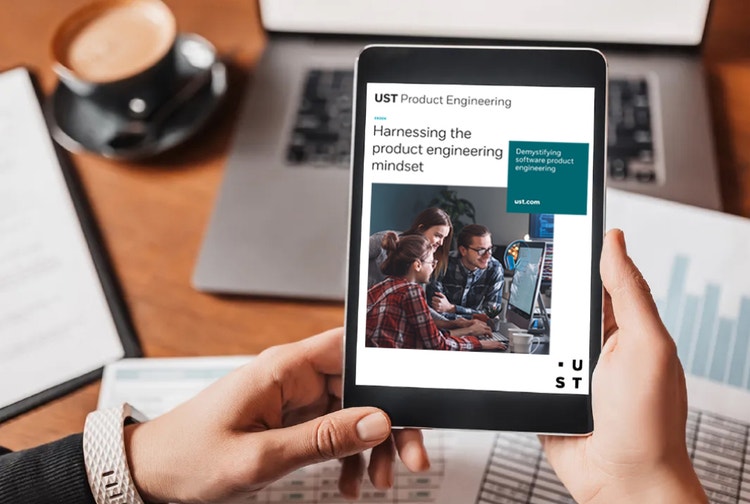

Insights
Transforming the world: Product Engineering meets Generative AI
UST Product Engineering
Generative AI allows engineers to create various designs within a set metrics field. By setting the parameters for the generative AI, it can produce several designs for the same product using complex algorithms.
UST Product Engineering
Related content
AI is becoming more prevalent across industries, yet the level of integration varies considerably. By accelerating the rate of data gathering, AI has given people the freedom to think more broadly and dynamically. Previously time-consuming research and information collection can now be done faster, allowing teams to explore more avenues of thought and expand the scope of business. This is changing the modus operandi of countless industries, from legal professions to sports analytics. It is also radically transforming product engineering.
Product engineering is how products are conceived, developed, and deployed. While generative AI technology is far from simple, it is an investment with many benefits, with adequate and case-specific training. Everything from the chalkboard to the store shelf is encompassed in this lifecycle AI is bringing newfound speed and agility to this process. AI is accelerating engineering, reducing costs, and enhancing the efficiency of the process to a still unknown but considerable degree.
DIVIDER
How Generative AI is impacting product engineering
While generative AI improves the overall product engineering process, dissecting the specific ways this improvement occurs is crucial.
- Precise testing for specific needs
Generative AI allows engineers to create various designs within a set metrics field. By setting the parameters for the generative AI, it can produce several designs for the same product using complex algorithms. This enables precise testing for specific needs. This gives products engineered using generative AI a superior level of innovation. - Measuring effectiveness at design stage
During the product design phase, they can be evaluated using generative AI to measure their performance. This allows engineers to track and analyze products and implement new variations to enhance the product further before it reaches the market. - Cost-effective ad user-oriented
Metrics like user feedback and manufacturing cost can all be used to generate designs, meaning that products developed using generative AI can be as cost-effective and user-oriented as possible. This also saves money from a quality control standpoint. - Integration of diverse data sources
The cross-platform integration generative AI brings allows multiple viewpoints to be harmonized through integrating diverse data sources, enabling development to occur with a more dynamic edge that harnesses multiple human perspectives but also the data analytics machines offer.
DIVIDER
Generative AI is transforming existing products
Several key tools allow humans to program generative AI to incorporate user feedback more intuitively in modeling. Ratings, reinforcement learning, and user interaction tracking allow AIs to consider quantitative metrics in producing qualitative outcomes for users. Furthermore, we are only in the nascent stage of using AI, and human-in-the-loop systems provide space for flesh-and-blood to monitor and correct the behavior and thinking of generative AIs.
The ways generative AI improves the design of new products are also applicable to refining existing products. Aspects like user feedback can be applied with new levels of depth to iterate new revisions to existing products.
Aeronautics company Airbus used generative AI to develop a more efficient wingtip for its Airbus model plane, resulting in a 3.5% reduction in fuel consumption. Another poignant example is Adidas: using generative AI and setting parameters for cost, durability, and structure, Adidas was able to design a lattice-like structure for its shoes that offered wearers greater support with enhanced durability, adding value.
Many existing products – most especially software – have maintenance and updates. Software updates can transform the user experience without necessarily requiring a new purchase. This expectancy is built into the cost modeling and ensures a product continues to offer users value as a market evolves.
Generative AI can help produce robust, custom solutions to user feedback, identifying and solving user issues in real-time while iterating various updates to keep the software more competitive. AI that can solve these tasks is cost-saving and frees engineers to focus on more humanistic elements of the user experience.
Of course, implementing and honing generative AI systems to a point where they can be useful for engineers and not a separate area of focus takes time and resources. More often than not, human input and monitoring is required. While the potential for generative AI can be useful, we should recognize the time and labor costs in onboarding these.
DIVIDER
How Generative AI reduces the time to market for new products
Getting products to market is a process of establishing and keeping a timeline. Challenges almost always arise and then must be accounted for. Generative AI allows product engineers to examine a product from several different designs, which helps development account for potential difficulties.
Rather than develop one prototype, work on it linearly, and address challenges as they come, the capability to design the same thing from multiple angles using generative AI gives a nimble edge to engineers. Furthermore, by addressing pitfalls preemptively and working with algorithms that can already account for user feedback and cost calculations, products can become market-ready in a dramatically faster and cheaper way than has previously been the case.
Successful product engineering is about identifying clear goals, firmly grounding a product in those goals, and maintaining the agility to pivot as the market requires. Simulations are some of the best ways to anticipate how markets will evolve and how a product may need to change. The complex algorithms generative AI works with enable engineers to run through countless scenarios by adjusting the parameter inputs of a simulation, giving the process a hedge against the future that saves time, money, and user experience quality.
DIVIDER
Reducing the cost of product development
The costliest part of product development is the sourcing and analyzing of information. With accurate information, it is possible to know market needs, how to meet them, and the cost of doing so. Getting the informational aspect of product engineering right is essential since a poorly chartered course usually costs time and money to correct later.
While in the past sifting through information was a thing of tedium, generative AI gives a powerful structure to this process. Not only can generative AI source information, but it can comb through the more than 3.5 quintillion bytes of data created daily. Therefore, the iterative process that comes from analyzing information is significantly reduced in time and money costs while bringing about a faster time to market.
Whether the question is a business strategy or product development, the ability to shape poignant questions and get answers can save companies phenomenal costs in R&D, strategy planning, and implementing user feedback. Companies that release a product at the MVP stage can use generative AI to take user feedback in whatever quantity it comes to extrapolate the best updates and upgrades to introduce in a product’s lifecycle, being ahead of the curve of customer expectations. Legacy products can also better analyze how to maintain and enhance their existing offerings using scenario planning. Across the board, the agility and ability to engineer products to meet changing customer needs at a revolutionary rate.
DIVIDER
Conclusion
The speed and in-depth processing of information generative Ai brings to product engineering transform the process entirely. Everything in the stages of product engineering is touched by the power of this new technology, from what questions to ask to answer them. Products can be designed with lower costs, less time, and more success when reaching users. It is a transformation in the way we make things.
However, there is still a long road ahead for generative AI adoption. While enterprises in specific industries have more readily adopted AI, others are only beginning to do so. Furthermore, even in sectors where AI has been in use, a great deal of effort and resources need to go into making generative AI valuable, and it can hardly be called a quick payoff. While human presence and input are extremely important at such an early stage in the growth of Generative AI, the potential is immense.
Learn more about UST Product Engineering solutions and how it can impact your business.


